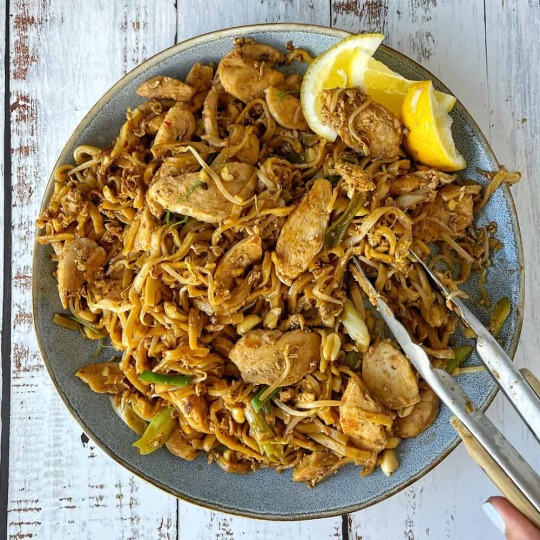#pad Thai
Text
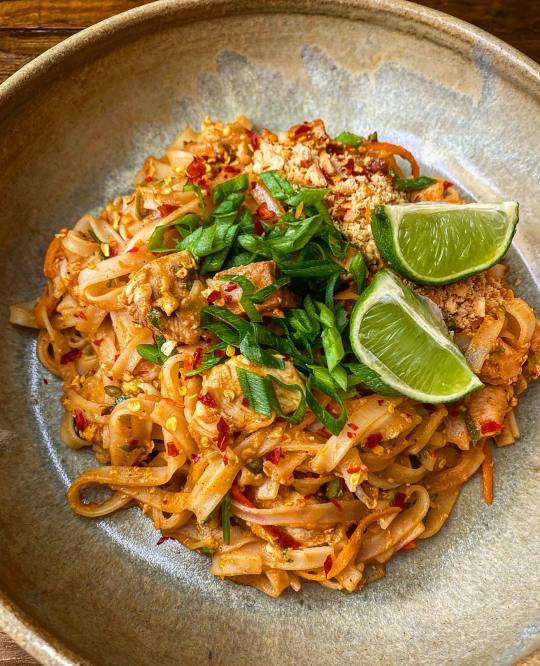
Pad Thai (via Instagram)
207 notes
·
View notes
Text
274 notes
·
View notes
Photo

Sriracha pad thai
#pad thai#noodles#sriracha#chicken#food#dinner#meal#thai food#asian food#spicy food#spicy#chicken pad thai#main course#tasty#foodporn#delicious#cooking#food photography#foodgasm#recipe
474 notes
·
View notes
Text
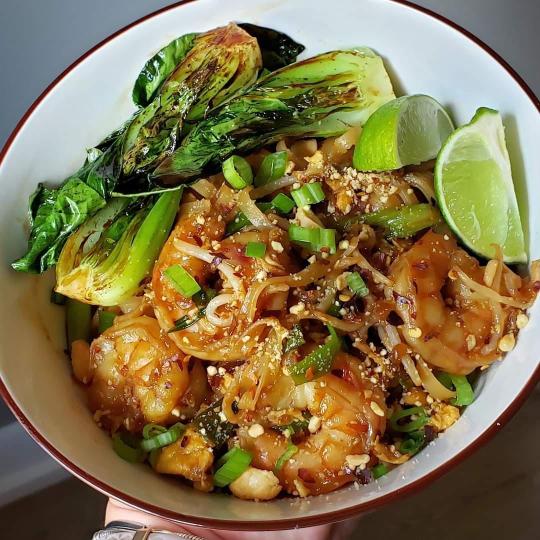
King Prawn Pad Thai with Bok Choy
57 notes
·
View notes
Text

295 notes
·
View notes
Text
I just saw the post about Quesadilla without cheese is just Dilla. And I think about the thing I hate the most about food globalisation.
The Raw Pad Thai.

No, motherfuckers!!!
Pad in Pad Thai means stir fried. There's no such thing like RAW Pad Thai.
This dish is just a Yum(Thai style spicy salad).
This is Pad Thai.

Pad Thai could be made vegan but it MUST be stir fried.
If you said the word raw Pad Thai I hate you all with a passion.
358 notes
·
View notes
Text
I'm making some pad thai sauce, which is supposed to be for supper tomorrow, but it smells so good that I may make the executive decision to have it for supper tonight.
If it tastes as good as it smells, it will be
a) the best pad thai I've made so far
b) entirely impossible to recreate, since I stretched my fish sauce with soy sauce and anchovies, and stretched my brown sugar with honey and molasses.
#I know it's supposed to be palm sugar#but brown sugar is much easier to find#and I have a hunch that honey will make a better substitution than white sugar#I have no excuse for the fish sauce except that I had more tamarind than I thought and ran out of fish sauce#delights#dandelion cooks#cooking#pad thai
33 notes
·
View notes
Text
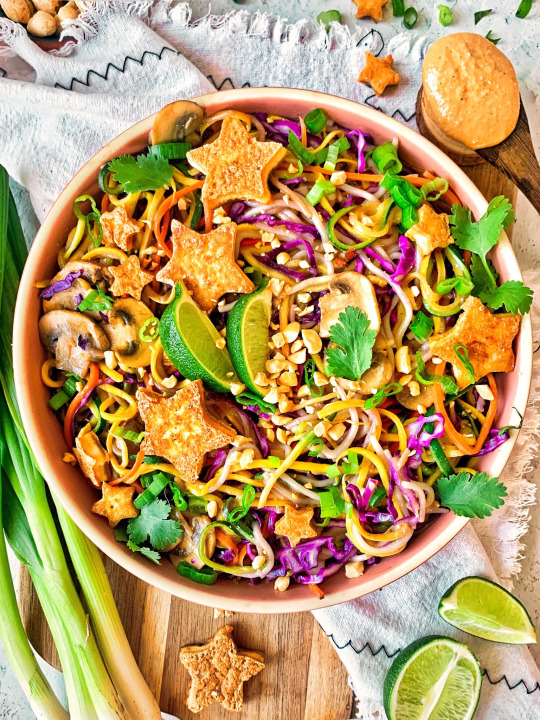
Vegan Rainbow Pad Thai with Veggie Noodles
#vegan#lunch#dinner#thai cuisine#southeast asian cuisine#noodle bowl#pad thai#noodles#zoodles#zucchini#carrots#cabbage#mushrooms#tofu#garlic#green onion#tamari#coconut aminos#coconut oil#lime#peanut butter#coconut milk#eat the rainbow
41 notes
·
View notes
Text

Peanut Butter and Purple Sprouting Broccoli Pad Thai
#food#vegan#thai food#pad thai#peanut butter#noodles#noodle bowl#tofu#vegetables#nuts#comfort food#recipe
39 notes
·
View notes
Text
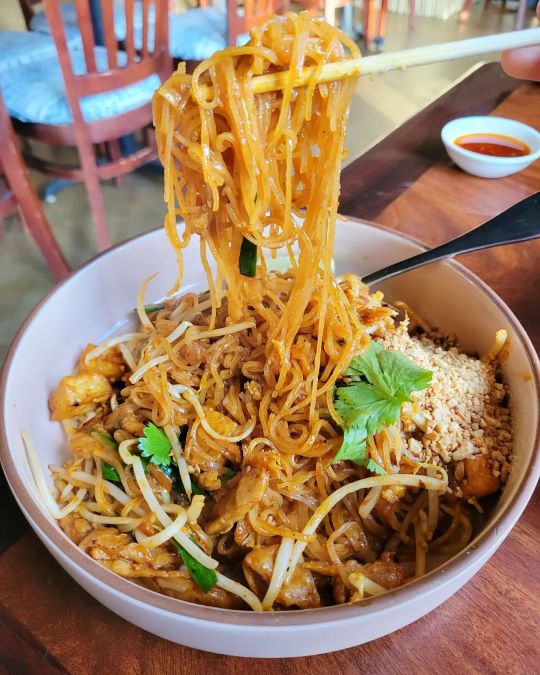
Pad Thai (via Instagram)
315 notes
·
View notes
Text

[ID: Rice noodles topped with yellow fried tofu and chives; piles of chili powder, peanuts, and chive stems to the side. End ID]
ผัดไทย / Phad thai (Thai noodle dish with tamarind and chives)
Phad thai, or pad thai ("Thai stir-fry") is a dish famous for its balance of sour, sweet, savory, and spicy flavors, and its combination of fried and fresh ingredients. It's commonly available in Thai restaurants in the U.S.A. and Europe—however, it's likely that restaurant versions aren't vegetarian (fish sauce!), and even likelier that they don't feature many ingredients that traditionalists consider essential to phad thai (such as garlic chives or sweetened preserved radish—or even tamarind, which they may replace with ketchup).
Despite the appeals to tradition that phad thai sometimes inspires, the dish as such is less than 100 years old. Prime Minister Plaek Phibunsongkhram popularized the stir-fry in the wake of a 1932 revolution that established a constitutional monarchy in Thailand (previously Siam); promotion of the newly created dish at home and abroad was a way to promote a new "Thai" identity, a way to use broken grains of rice to free up more of the crop for export, and a way to promote recognition of Thailand on a worldwide culinary stage. Despite the dish's patriotic function, most of the components of phad thai are not Thai in origin—stir-fried noodles, especially, had a close association with China at the time.
My version replaces fish sauce with tao jiew (Thai fermented bean paste) and dried shrimp with shiitake mushrooms, and uses a spiced batter that fries up like eggs. Tamarind, palm sugar, prik bon (Thai roasted chili flakes), and chai po wan (sweet preserved radish) produce phad thai's signature blend of tart, sweet, and umami flavors.
Recipe under the cut!
Patreon | Tip jar
Serves 2.
Ingredients:
For the sauce:
3 Tbsp (35g) Thai palm sugar (น้ำตาลปึก / nam tan puek)
2 Tbsp vegetarian fish sauce, or a mixture of Thai soy sauce and tao jiew
1/4 cup tamarind paste (made from 50g seeded tamarind pulp, or 80g with seeds)
Thai palm sugar is the evaporate of palm tree sap; it has a light caramel taste. It can be purchased in jars or bags at an Asian grocery, or substituted with light brown sugar or a mixture of white sugar and jaggery.
Seedless tamarind pulp can be purchased in vacuum-sealed blocks at an Asian grocery store—try to find some that's a product of Thailand. I have also made this dish with Indian tamarind, though it may be more sour—taste and adjust how much paste you include accordingly.
You could skip making your own tamarind paste by buying a jar of Thai "tamarind concentrate" and cooking it down. Indian tamarind concentrate may also be used, but it is much thicker and may need to be watered down.
For the stir-fry:
4oz flat rice noodles ("thin" or "medium"), soaked in room-temperature water 1 hour
1/4 cup chopped Thai shallots (or substitute Western shallots)
3 large cloves (20g) garlic, chopped
170g pressed tofu
3 Tbsp (23g) sweet preserved radish (chai po wan), minced
1 Tbsp ground dried shiitake mushroom, or 2 Tbsp diced fresh shiitake (as a substitute for dried shrimp)
Cooking oil (ideally soybean or peanut)
The rice noodles used for phad thai should be about 1/4" (1/2cm) wide, and will be labelled "thin" or "medium," depending on the brand—T&T's "thin" noodles are good, or Erawan's "medium." They may be a product of Vietnam or of Thailand; just try to find some without tapioca as an added ingredient.
Pressed tofu may be found at an Asian grocery store. It is firmer than the extra firm tofu available at most Western grocery stores. Thai pressed tofu is often yellow on the outside. If you can't locate any, use extra firm tofu and press it for at least 30 minutes.
Sweetened preserved radish adds a deeply sweet, slightly funky flavor and some texture to phad thai. Make sure that your preserved radish is the sweet kind, not the salted kind.

For the eggs
¼ cup + 2 Tbsp (60g) white rice flour
3 Tbsp (22.5g) all-purpose flour (substitute more rice flour for a gluten-free version)
1 tsp ground turmeric
About 1 ¼ cup (295mL) coconut milk (canned or boxed; the kind for cooking, not drinking)
¼ tsp kala namak (black salt), or substitute table salt
Pinch prik bon (optional)
To serve:
Prik bon
2 1/2 cups bean sprouts
3 bunches (25g) garlic chives
1 banana blossom (หัวปลี / hua plee) (optional)
1/3 cup peanuts, roasted
Additional sugar
Garlic chives, also known as Chinese chives or Chinese leeks, are wider and flatter than Western chives. They may be found at an Asian grocery; or substitute green onion.
Banana blossoms are more likely to be found canned than fresh outside of Asia. They may be omitted if you can't find any.
Instructions:
For the eggs:
1. Whisk all ingredients together in a mixing bowl. Cover and allow to rest.
For the noodles:
1. Soak rice noodles in room-temperature water for 1 hour, making sure they're completely submerged. After they've been soaked, they feel almost completely pliant. Cut the noodles in half using kitchen scissors.
For the tamarind paste:
1. Break off a chunk of about 50g seedless tamarind, or 80g seeded. Break it apart into several pieces and place it at the bottom of a bowl. Pour 2/3 cup (150mL) just-boiled water over the tamarind and allow it to soak for about 20 minutes, until it is cool enough to handle.
2. Palpate the tamarind pulp with your hands and remove hard seeds and fibres. Pulverise the pulp in a blender (or with an immersion blender) and pass it through a sieve—if you have something thicker than a fine mesh sieve, use that, as this is a thick paste. Press the paste against the sieve to get all the liquid out and leave only the tough fibers behind.
You should have about 1/4 cup (70g) of tamarind paste. If necessary, pour another few tablespoons of water over the sieve to help rinse off the fibers and get all of the paste that you can.
3. Taste your tamarind paste. If it is intensely sour, add a little water and stir.
For the sauce:
1. If not using vegetarian fish sauce, whisk 1 Tbsp tao jiew with 1 Tbsp Thai soy sauce in a small bowl. You can also substitute tao jiew with Japanese white miso paste or another fermented soybean product (such as doenjang or Chinese fermented bean paste), and Thai soy sauce with Chinese light soy sauce. Fish sauce doesn't take "like" fish, merely fermented and intensely salty, and that's the flavor we're trying to mimic here.
2. Heat a small sauce pan on medium. Add palm sugar (or whatever sugar you're using) and cooking, stirring and scraping the bottom of the pot often, until the sugar melts. Cook for another couple of minutes until the sugar browns slightly.
3. Immediately add tamarind and stir. This may cause the sugar to crystallize; just keep cooking and stirring the sauce to allow the sugar to dissolve.
4. Add fish sauce and stir. Continue cooking for another couple of minutes to heat through. Remove from heat. Taste and adjust sugar and salt.
To stir-fry:
1. Cut the tofu into pieces about 1" x 1/4" x 1/4" (2.5 x 1/2 x 1/2cm) in size.
2. Separate the stalks of the chives from the greens and set them aside for garnish. Cut the greens into 1 1/2” pieces.
3. Chop the shallots and garlic. If using fresh shiitake mushrooms, dice them, including the stems. If using dried, grind them in a mortar and pestle or using a spice mill.
4. Roast peanuts in a skillet on medium heat, stirring often, until fragrant and a shade darker.
5. Remove the tough, pink outer leaves of the fresh banana blossom until you get to the white. Cut off the stem and cut lengthwise into wedges (like an orange). Rub exposed surfaces with a lime wedge to prevent browning. If your banana blossom is canned, drain and cut into wedges.
6. Heat a large wok (or flat-bottomed pan) on medium-high. Add oil and swirl to coat the wok's surface.
If you're using extra firm (instead of pressed) tofu, fry it now to prevent it from breaking apart later. Add about 1" (2.5cm) of oil to the wok, and fry the tofu, stirring and flipping occasionally, until golden brown on all sides. Remove tofu onto a plate using a slotted spoon. Carefully remove excess oil from the wok (into a wide bowl, for example) and reserve for reuse.
7. Fry shallots, garlic, preserved radish and tofu (if you didn't fry it before), stirring often, until shallots are translucent. Add mushroom and fry another minute.
8. Add pre-fried tofu, drained noodles, and sauce to the wok. Cook, stirring often with a spatula or tossing with tongs, until the sauce has absorbed and the noodles are completely pliant and well-cooked. (If sauce absorbs before the noodles are cooked, add some water and continue to toss.)
9. Push noodles to the side. Add 'egg' batter and re-cover with the noodles. Cook for a couple minutes, until the egg had mostly solidified. Stir to break up the egg and mix it in with the noodles.
10. Remove from heat. Add half the roasted peanuts, half of the bean sprouts, and all of the greens of the chives. Cover for a minute or two to allow the greens to wilt.
11. Serve with additional peanuts, bean sprouts, banana blossom wedges, chive stems, and lime wedges on the side. Have prik bon and additional grated palm sugar at table.
127 notes
·
View notes
Photo

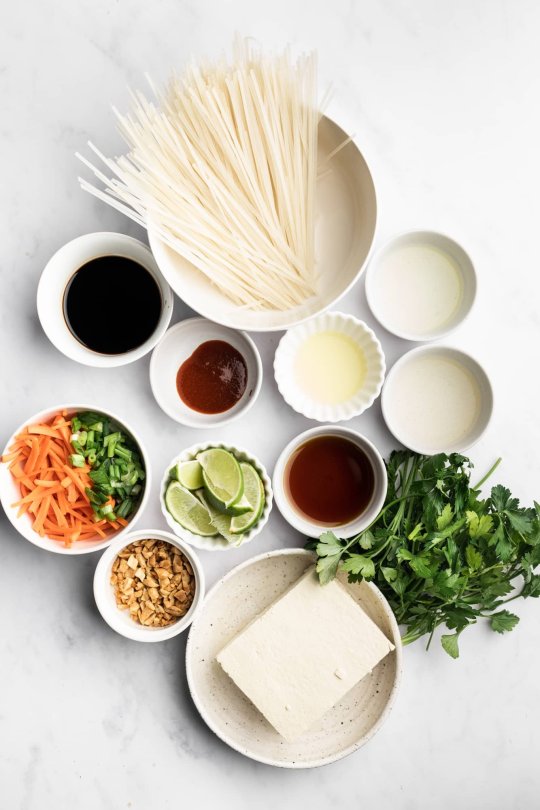

Vegan Pad Thai
386 notes
·
View notes
Text
🚨SPOILERS FOR FANTASY HIGH JUNIOR YEAR EPISODE 4!!!🚨
Dimension20 "Fantasy High Junior Year"
Episode 4 "Under Pressure"
Timestamp: 1:37:06
Video Length: 42 sec.
Kristen tries to order 10 Pad Thais
😂😂😂
Kristen rolls to order pad thais 😂😂😂
Brennan is so confused as to why Ally is rolling dice for it 😂😂😂
Emily is also confused about why they rolled without being asked to roll anything first 😂😂🤣🤣💀💀
Siobahn: "What are your pad thai stats?" 😂
Brennan: "I'm trying to think narratively how a success or failure on ordering pad thai-" 😂
Ally says that it was because the pad for ordering was really hard to use! 😂🤣💀
Fabian had tried to use it all morning 😂💀
Intelligence roll
Siobahn: "how smart is Kristen?"
Ally: "17"
😂😂😂
Ally successfully orders 10 pad thais for everyone and Gorgug decides to stay over for a little longer to study at Fabian's house! 😆👏💯
#dimension 20#dimension20#blog#fantasy high#fantasy high junior year#under pressure#fantasy high under pressure#fantasy high junior year episode 4#fantasy high scene#fantasy high junior year scene#dimension20 scene#queue#the bad kids#bad kids#the intrepid heroes#intrepid heroes#brennan lee mulligan#pad thai#ally beardsley#siobhan thompson#emily axford#zac oyama
24 notes
·
View notes
Text
Tonight’s Special
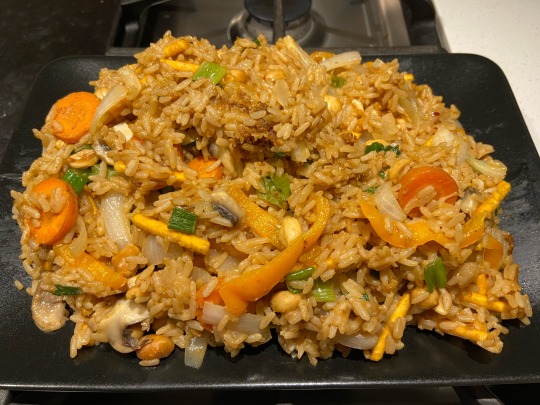
Pad-Thai peanut 🥜 fried rice 🍚
#food#foodblogger#foodgawker#foodpost#foodpics#foodgram#home cooking#cooking#rice#fried rice#pad thai#thai food#thai cuisine#thai cooking#vegetables#carrots#peanuts#mushrooms#vegetarian#vegan#onion#green onions#bell peppers
28 notes
·
View notes
Text



So I harvested some of the garlic scapes this morning. It was such a great addition to the Pad Thai we had for lunch.
28-Jun-2023
#foodporn#food#food porn#pad thai#garlic plant#garlic#garlic scapes#foodblr#garden#harvest#garden 2023#yummy#asian flavors
38 notes
·
View notes
